Abstract
Rolling stock manufacturers face the challenge of manufacturing lightweight high-speed trains without deteriorating comfort. One of the difficulties is to mantain or increase structural stiffness and damping as the car bodies become lighter. Leaving aside active solutions, which are expensive and generally complex to implement, increasing structural damping by means of viscoelastic patches (via Constrained Layer Damping) seems to be a viable solution which is in fact already used for acoustic insulation in automotive, aerospace and even railway applications. Although there are works in the literature that try to optimise viscoelastic panels, this work presents an experimental study with two essential contributions: (i) to analyse the influence of a broad set of design parameters such as type of the constraining layer (uniform or honeycomb), thickness of the viscoelastic layer, location, covered area and continuity between patches; and (ii) to consider absolute and specific (per unit mass) damping depending on the design scenario. To locally increase the structural damping of an existing lightweight structure without compromising its weight, partial application of thin viscoelastic and constraining layers turned out to be the best solution. To enhance structural damping from the design stages, disregarding constraining layer mass by incorporating its stiffness into the overall stiffness of the structure, full coverage with thick viscoelastic layer and a honeycomb constraining layer with a high cross-section moment of inertia turned out to be the best option, reaching modal damping ratios up to 22 times higher than structures without viscoelastic materials.
1. Introduction
The trend of the railway industry towards higher speeds is undeniable. These demands for higher speeds increase the requirements for lighter car bodies, in order to reduce the loads between wheel and rail, manufacturing costs and energy consumption. Lowering the car body weight leads to a reduction in structural stiffness and natural frequencies. Moreover, higher speeds generate more pronounced accelerations on the vehicle, causing resonance vibrations of flexible modes which adversely affect ride comfort [1].
There are several approaches to reduce car body vibrations from flexible modes and ensure acceptable ride comfort: either focusing on its structural stiffness or optimising damping. Methods for actively reducing car body vibrations of a railway vehicle have not found excessive success, quite possibly because the solutions are too expensive in relation to the benefits. This paper focuses on passive damping.
Two types of layered damping structures are available. The first is the unconstrained or free layer damping treatment (FLD), where a damping material is attached to the base panel. Vibration energy is dissipated by means of the extension and compression of the damping material when the flexural vibration takes place on the panel. The second is the constrained layer damping treatment (CLD) in which the damping material is sandwiched by two panels stiffer than the damping material. Bending of the panels translates into shear strain of the damping material, improving its performance [2,3]. Some authors [4,5,6,7] apply these passive damping technologies (FLD and CLD) using viscoelastic materials to isolate vibrations in commercial vehicles, railway vehicles and aircrafts, but they generally focus on noise reduction rather than comfort-related low-frequency flexible modes. Sound absortion in these industries is being pursued by using new low-weight materials, such as electrospun nanomaterials [8,9]. Additionally, recent works have studied the reduction in dynamic stresses and accelerations when applying aluminium foam as an energy-absorbing material for the carrying structure of railway cars [10,11].
The type of viscoelastic material as well as the thickness of the damping layer have been studied [12,13]. Location and area covered of these CLD patches are also critical factors. In the automotive, aerospace or railway industries, which strive for lightweight structures, partial-coverage (as opposed to full-coverage) is a must. Nokes and Nelson [14] were among the first researchers to study modal loss factors of partially covered sandwich beams. Parathasarathy et al. [15] and, with more thorough analytical studies, Lall et al. [16,17], proved that higher values of modal damping can be obtained with a partially covered beam in comparison to a fully covered one. More recently, new techniques have been used for the topological optimisation of CLD structures. Zheng et al. [18] first used Genetic Algorithms in order to locate optimal positions for the passive damping patches in cylindrical shell structures. Later, also Zheng et al. [19] performed a topological optimisation based on the Method of Moving Asymptotes. In recent years, we can find several valuable analytical contributions in this field [20,21,22,23,24].
These studies encourage us to explore the performance of different configurations of CLD railway structural components from an experimental point of view. In this work, we focus on laboratory-scale aluminium beams taken from the floor of a lightweight railway vehicle (and with similar stiffness per unit width) to experimentally compare different solutions: type of constraining layer (uniform or honeycomb), thickness of the viscoelastic layer, location, area covered and continuity between patches. The objective is to find (via Experimental Modal Analysis) the CLD configuration that provides the highest absolute and specific (per unit mass) modal damping.
2. Experimental Study
2.1. Ligthweight Car Body Specimen
The experimental study in this work focuses on a laboratory-scale specimen corresponding to a portion of the floor of a railway vehicle (see Figure 1), an aluminium extruded structure, about 13 m long and 3.25 m wide, composed of two flange sheets separated by a distance of about 50 mm by perpendicular web components every 110 mm in the transverse direction.
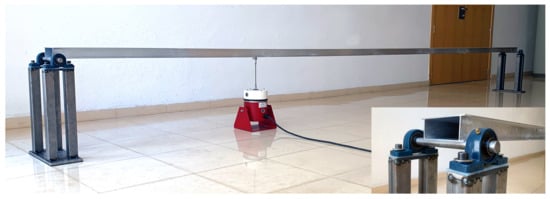
Figure 1.
Pinned–pinned lightweight aluminium beam and detail of the supports.
The beam-shaped specimen is taken as a portion with two webs, 130 mm width and 5078 mm in length. These dimensions have been chosen so that the stiffness per unit width of this laboratory-scale specimen is similar to that of the railway floor. The material density is 2700 kg/m, its Young’s Modulus 70 GPa, the beam mass is kg, its cross section area 919 mm and its area moment of inertia mm.
2.2. CLD Type and Location
Figure 2 shows the different types of CLD patches considered. Type A is the original specimen, whereas types B and C are constructed by attaching a rigid (uniform or honeycomb) sheet of aluminium to a layer of viscoelastic polymer. The constraining layer used for specimens B corresponds to an aluminium sheet 2500 mm long, 125 mm wide and 6 mm thick. For the case of specimens C, a 20 mm thick honeycomb is used, built with 0.08 mm aluminium foil and with a hexagonal cell size of 6.4 mm. This honeycomb is sandwiched between two aluminium sheets of different thickness, the thickest being the furthest from the aluminium beam.

Figure 2.
Types of beams: (a) without CLD; (b) CLD patch with uniform constraining layer; (c) CLD patch with honeycomb constraining layer.
Two different thicknesses (1 mm and 2 mm) of viscoelastic polymer are used for specimens B as well as for specimens C. The length and width of this polymer layer match that of their respective constraining layers. Twelve different cases of partial passive treatment with CLD on the aluminium beam (as shown in Figure 3 and detailed in Table 1) will be evaluated experimentally.

Figure 3.
CLD configurations.

Table 1.
CLD parameters.
The viscoelastic polymer is commercially manufactured by Heathcote Industrial Plastics and is designed specifically to provide a maximum and stable loss factor in the frequency range of interest (5–60 Hz). For an ambient temperature of 20 °C, the corresponding loss factor is about .
2.3. Test Bench
Experimental Modal Analyses (EMA) are carried out with the aluminium beam on simple supports (Figure 1).
Figure 4 shows the schematics of the excitation and measurement system. A set of 9 accelerometers are attached to the bottom side of the beam. Two of these sensors are located at the beam ends and another one is positioned at the center of the beam. The rest of the accelerometers are evenly distributed on the beam. The accelerometers used are model 333B50 from PCB Piezotronics, with a nominal sensitivity of 1000 mV/g and a weight of 7.5 g.
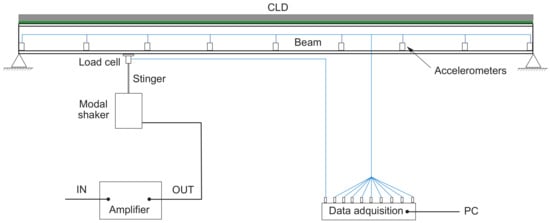
Figure 4.
Schematics of excitation and measurement systems.
A modal shaker model GW–V20 from Data Physics Corporation with a capacity of up to 100 N provides the excitation. This shaker is located as shown in Figure 4, and is connected to the beam through a stinger with a load cell to provide a precision measure of the force signal. The load cell used is model 208C02 from PCB Piezotronics with a sensitivity of 117.9 mV/N.
The excitation force corresponds to a white noise, with a level of to 0.6 N/Hz and a 3–70 Hz bandwidth. The signals from the force and acceleration sensors are logged for 90 s with a sampling rate of 200 Hz with a National Instruments Chassis cDAQ–9179 equipped with NI–9234 data acquisition modules (up to 56 channels) suitable for integrated electronic piezoelectric sensors (IEPE).
3. Experimental Results
An EMA was performed for each of the CLD structures considered with the commercial software “ModalView”, obtaining frequency and modal damping for the first three modes. Frequency Response Functions in our bandwidth of 100 Hz were obtained with 4096 frequency lines, so the frequency resolution is lower than 0.025 Hz. Modal damping and eigenfrequencies were estimated with the Linear Square Complex Frequency Estimator (LSCF) using discrete-time z-model, which is a widely used frequency-domain modal parameter estimation method which provides higher accuracy, stability, and calculation speed than other methods [25,26].
The modal shapes obtained for the beams tested are basically those for a pinned–pinned beam, although slight shifts of the vibration nodes were observed when the configurations were asymmetrical (B2 and C2).
CLD patches not only provide structural damping, but also add mass and stiffness to the structure, which results in a small variation of modal frequencies. Figure 5 shows the value of the natural frequency of the first mode of vibration in ascending order for the different configurations analysed. In general, all configurations (B type especially) contribute more mass than stiffness, resulting in a small reduction in the natural frequency with hardly any influence on passenger comfort. Similar trends and percentage reductions in frequency can be found when analysing the second and third flexible modes. All values are gathered in Table 2.
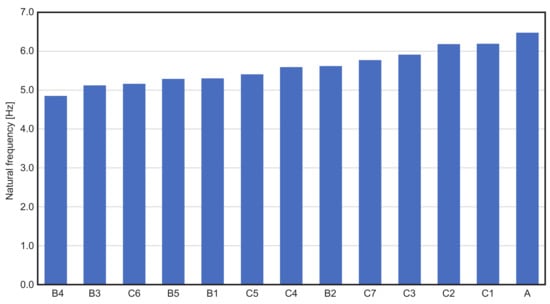
Figure 5.
Natural frequencies of the first mode of vibration for the different configurations (ranked from lowest to highest).

Table 2.
Modal parameters (natural frequency and absolute and specific damping coefficient) for the first three mode shapes of the different configurations.
Modal damping deserves further consideration. If one considers CLD patches as a mere addition of material to increase modal damping of a lightweight structure, mass is a critical factor and the highest specific damping (damping per unit mass) should be sought. However, if the structural engineer manages to design the structure so that the constraining layer contributes to the global structural stiffness, the weight of the constraining layer would no longer be relevant and the maximum absolute damping should be pursued.
Figure 6, Figure 7 and Figure 8 show the absolute and specific damping for the three flexible modes. All configurations increase structural damping significantly for all the modes. In the worst case (B4) for the first flexible mode, damping is four times higher than that of the reference beam (A), and in the best case (C6), the structural damping increases up to 22 times its initial value.
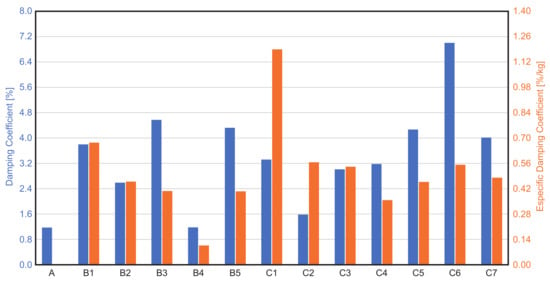
Figure 6.
Damping coefficients of the first mode of vibration for the different configurations.
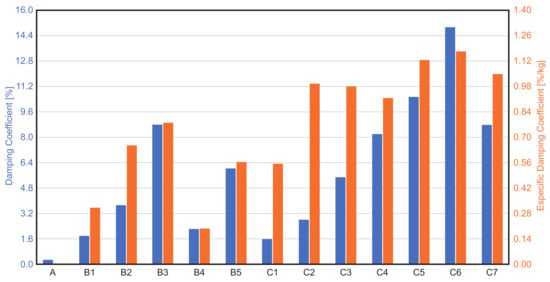
Figure 7.
Damping coefficients of the second mode of vibration for the different configurations.
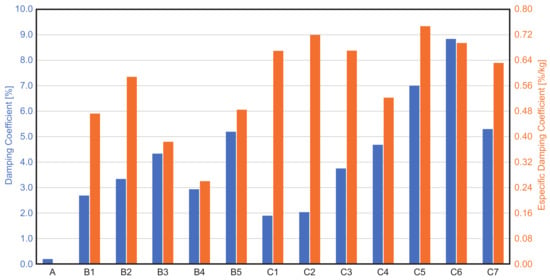
Figure 8.
Damping coefficients of the third mode of vibration for the different configurations.
The type of constraining layer can be analysed by comparing configurations B3 and C6, with similar added mass (around 12 kg each) and the rest of parameters being identical. In all modes, C6 achieves a higher damping (52%, 70% and 107% higher in modes 1, 2 and 3, respectively), so it would be convenient to design the constraining layer in such a way as to increase the inertia of the section to enhance the performance of the viscoelastic layer.
The effect of viscoelastic layer thickness can be studied by comparing configurations C3 and C7, with 2 and 1 mm viscoelastic layer thickness, respectively. It comes as a surprise that an increase in the viscoelastic layer thickness can be detrimental. Indeed, C3, with a 2 mm thick viscoelastic layer, reduces the structural damping of the three modes by about 30% with respect to C7.
The influence of the location of the constraining layer is analysed by comparing configurations C1 and C2 (or, alternatively, B1 and B2 with identical conclusions). In this case, results depend on modal shape. The centred position of the patch maximises the modal damping of the first mode but not that of the second and third modes. This result was predictable as the dissipation of the viscoelastic layer is amplified with the deformation of the structure, which is larger at antinodes.
The covered area is compared in configurations C1 (50%) and C3 (100%) or their analogues B1 and B3. It is obvious that a larger area covers antinodes of more vibration modes; therefore, the damping of modes 2 and 3 is greatly improved with 100% coverage. However, for mode 1 (the most comfort-relevant mode), 100% coverage is detrimental: modal damping is reduced by 10% when using full coverage. Comparing configurations B1 and B3, higher coverage is now not detrimental, but the improvement is mild: it improves damping by only 20% despite doubling the mass. In fact, in terms of specific damping, partial coverage is always preferable to full coverage (for mode 1). Indeed, C1 is the configuration that provides the greatest specific damping, more than 2.2 times higher than C3.
Finally, the continuity of the CLD patch has also been studied and can be analysed by comparing configurations B3 and B4. In all modes, a higher continuity of the constraining layer (2 segments versus 4) increases the dissipation of the viscoelastic layer and even triples the damping of the first two flexible modes.
Conclusions may differ depending on the requirements. If a solution is required to locally increase the structural damping of an existing lightweight structure without compromising its weight, C1 provides the highest specific damping (per unit mass): partial coverage centred on the most significant antinode via CLD patches with thin layers of both the viscoelastic and the honeycomb layers. However, if the search for higher structural damping is pursued from the design stages, the constraining layer can be enhanced without being concerned about its weight by incorporating its stiffness into the overall stiffness of the structure. In this case, C6 is the most suitable: full coverage via CLD patches with thick viscoelastic layer and a honeycomb constraining layer with a high cross section moment of inertia.
Figure 9 and Figure 10 show the Frequency Response Function (FRF) of an accelerometer for the configurations with uniform (B) and honeycomb (C) constraining layers, respectively. Figure 11 shows the FRF of an accelerometer for the two selected cases (C1 and C6) and the reference beam without CLD. The improvement of C6 over C1 is clear in these figures.
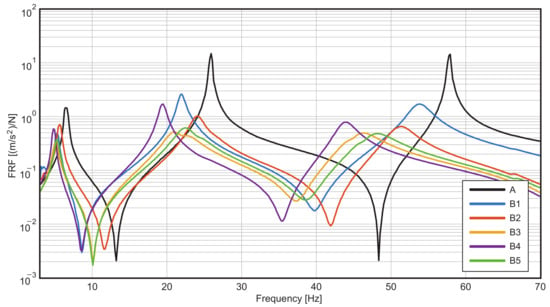
Figure 9.
FRF of the reference beam (A) and configurations with uniform constraining layer (B).
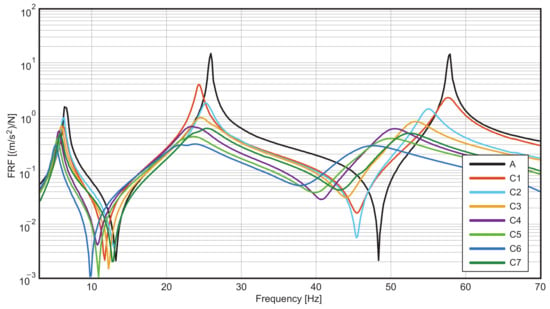
Figure 10.
FRF of the reference beam (A) and configurations with honeycomb constraining layer (C).
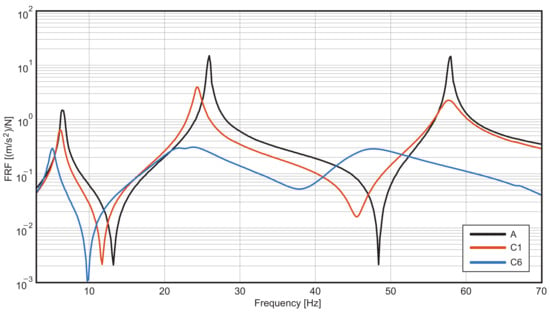
Figure 11.
FRF of the reference beam (A) and the configuration with the best absolute (C6) and specific (C1) damping coefficient.
4. Conclusions
In this work, a detailed experimental analysis of CLD viscoelastic damping for comfort improvement in high-speed trains has been carried out. The methodology consisted of Experimental Modal Analyses of laboratory-scale aluminium beams taken from the floor of a lightweight rail vehicle to which different CLD configurations were added.
Results have been extracted from the analysis of parameters such as the type of the constraining layer (uniform or honeycomb), thickness of the viscoelastic layer, location, covered area and continuity between patches. It should be emphasised that selecting honeycomb constraining layers yields damping ratios which are 52%, 70% and 107% higher (in modes 1, 2 and 3, respectively) than those with uniform constraining layers with similar added mass.
Optimal configurations are highly dependent on the mass requirements of the design scenario. For local damping of existing lightweight structures, parameters that optimise the specific damping, such as partial coverage and thin layers of both viscoelastic and constraining layers, should be used. However, the main potential of CLD is achieved when it is made part of the structural design contributing to its stiffness and strength. In this way, the modal damping could be up to 22 times that of the structures without CLD.
Standard EN–12299 for comfort evaluation in railway applications states that the comfort-relevant frequency range for humans is 3–30 Hz, so our recommendations to increase the modal damping of the first two modes of vibration of the lightweight structure (which are within said range) can translate into significant improvements of the ride comfort index.
Author Contributions
Conceptualisation, M.M. and A.J.N.; methodology, M.M.; software, M.M. and E.P.; validation, M.M. and A.L.M.; formal analysis, M.M., A.J.N. and E.P.; investigation, M.M. and A.J.N.; resources, A.L.M. and C.R.; data curation, E.P.; writing—original draft preparation, M.M. and A.L.M.; writing—review and editing, M.M., A.J.N. and P.P.; visualisation, M.M. and C.R.; supervision, A.L.M.; project administration, J.M.C.; funding acquisition, A.J.N., A.L.M., J.M.C. and P.P. All authors have read and agreed to the published version of the manuscript.
Funding
This work was supported by grant TRA-2017-83376-R, funded by MCIN/AEI/10.13039/501100011033 and “ERDF A way of making Europe”, and grant SBPLY/19/180501/000142, funded by JCCM-ERDF.
Acknowledgments
The authors would like to show their gratitude to the railway vehicle manufacturer “Patentes Talgo” for providing specimens for tests.
Conflicts of Interest
The authors declare no conflict of interest.
References
- Zhou, J.; Goodall, R.; Ren, L.; Zang, H. Influences of car body vertical flexibility on ride quality of passenger railway vehicles. Proc. IMechE Part F J. Rail Rapid Transit. 2009, 223, 461–471. [Google Scholar] [CrossRef]
- Nashif, A.; Jones, D.; Henderson, J. Vibration Damping; John Wiley: New York, NY, USA, 1985. [Google Scholar]
- Mead, D. Passive Vibration Control; John Wiley & Sons: Chichester, UK, 1998. [Google Scholar]
- Rao, M. Recent applications of viscoelastic damping for noise control in automobiles and commercial airplanes. J. Sound Vib. 2003, 262, 457–474. [Google Scholar] [CrossRef]
- Fan, R.; Meng, G.; Yang, J.; He, C. Experimental study of the effect of viscoelastic damping materials on noise and vibration reduction within railway vehicles. J. Sound Vib. 2009, 319, 58–76. [Google Scholar] [CrossRef]
- Furukava, M.; Gerges, S.; Neves, M.; Coelho, B. Analysis of structural damping performance in passenger vehicles chassis. J. Acoust. Soc. Am. 2009, 126, 2280. [Google Scholar] [CrossRef]
- Danti, M.; Vige, D.; Nierop, G. Modal methodology for the simulation and optimization of the free-layer damping treatment of a car body. J. Vib. Acoust. 2010, 132, 021001. [Google Scholar] [CrossRef]
- Giannella, V.; Branda, F.; Passaro, J.; Petrone, G.; Barbarino, M.; Citarella, R. Acoustic improvements of aircraft headrests based on Electrospun Mats evaluated through Boundary Element Method. Appl. Sci. 2020, 10, 5712. [Google Scholar] [CrossRef]
- Giannella, V.; Colangeli, C.; Cuenca, J.; Citarella, R.; Barbarino, M. Experimental/Numerical acoustic assessment of aircraft seat headrests based on Electrospun Mats. Appl. Sci. 2020, 11, 6400. [Google Scholar] [CrossRef]
- Fomin, O.; Gorbunov, M.; Lovska, A.; Gerlici, J.; Kravchenko, K. Dynamics and strength of circular tube open wagons with aluminum foam filled center sills. Materials 2021, 14, 1915. [Google Scholar] [CrossRef]
- Fomin, O.; Gorbunov, M.; Gerlici, J.; Vatulia, G.; Lovska, A.; Kravchenko, K. Research into the strength of an open wagon with double sidewalls filled with aluminium foam. Materials 2021, 14, 3420. [Google Scholar] [CrossRef]
- Alam, N.; Asnani, N. Vibration and damping analysis of multilayered rectangular plates with constrained viscoelastic layers. J. Sound Vib. 1984, 97, 597–614. [Google Scholar] [CrossRef]
- Yildiz, A.; Stevens, K. Optimum thickness distribution of unconstrained viscoelastic layer treatment for plates. J. Sound Vib. 1985, 103, 183–199. [Google Scholar] [CrossRef]
- Nokes, D.; Nelson, F. Constrained layer damping with partial coverage. Shock Vib. 1968, 38, 5–10. [Google Scholar]
- Parathasarathy, G.; Reddy, C.; Ganesan, N. Partial coverage of rectangular plates by unconstrained layer damping treatments. J. Sound Vib. 1985, 102, 203–216. [Google Scholar] [CrossRef]
- Lall, A.; Asnani, N.; Nakra, B. Vibration and damping analysis of rectangular plate with partially covered constrained viscoelastic layer. J. Vib. Acoust. Stress. Reliab. Des. 1987, 109, 241–247. [Google Scholar] [CrossRef]
- Lall, A.; Asnani, N.; Nakra, B. Damping analysis of partially covered sandwich beams. J. Sound Vib. 1988, 123, 247–259. [Google Scholar] [CrossRef]
- Zheng, H.; Cai, C.; Pau, G.; Liu, G. Minimizing vibration response of cylindrical shells through layout optimization of passive constrained layer damping treatments. J. Sound Vib. 2005, 279, 739–756. [Google Scholar] [CrossRef]
- Zheng, L.; Xie, R.; Wang, Y.; Adel, E. Topology optimization of constrained layer damping on plates using Method of Moving Asymptote MMA approach. Shock Vib. 2011, 18, 221–244. [Google Scholar]
- Ansari, M.; Khajepour, A.; Esmailzadeh, E. Application of level set method to optimal vibration control of plate structures. J. Sound Vib. 2013, 332, 687–700. [Google Scholar] [CrossRef]
- Takezawa, A.; Daifuku, M.; Nakano, Y.; Nakagawa, K.; Yamamoto, T.; Kitamura, M. Topology optimization of damping material for reducing resonance response based on complex dynamic compliance. J. Sound Vib. 2016, 365, 230–243. [Google Scholar] [CrossRef]
- Liu, Q.; Ruan, D.; Huang, X. Topology optimization of viscoelastic materials on damping and frequency of macrostructures. Comput. Methods Appl. Mech. Eng. 2018, 337, 305–323. [Google Scholar] [CrossRef]
- Xie, X.; Zheng, H.; Jonckheere, S.; Desmet, W. Explicit and efficient topology optimization of frequency-dependent damping patches using moving morphable components and reduced-order models. Comput. Methods Appl. Mech. Eng. 2019, 355, 591–613. [Google Scholar] [CrossRef]
- Madeira, J.; Araújo, A.; Soares, C.M. Multiobjective optimization of constrained layer damping treatments in composite plate structures. Mech. Adv. Mater. Struct. 2017, 24, 427–436. [Google Scholar] [CrossRef]
- Verboven, P.; Guillaume, P.; Cauberghe, B.; Vanlanduit, S.; Parloo, E. Modal parameter estimation from input-output Fourier data using frequency-domain maximum likelihood identification. J. Sound Vib. 2004, 276, 957–979. [Google Scholar] [CrossRef]
- El-Kafaty, M.; Peeters, B.; Guillaume, P.; De Trover, T. Constrained maximum likelihood modal parameter identification applied to structural dynamics. Mech. Syst. Signal Process. 2007, 72–73, 567–589. [Google Scholar]
Publisher’s Note: MDPI stays neutral with regard to jurisdictional claims in published maps and institutional affiliations. |
© 2022 by the authors. Licensee MDPI, Basel, Switzerland. This article is an open access article distributed under the terms and conditions of the Creative Commons Attribution (CC BY) license (https://creativecommons.org/licenses/by/4.0/).